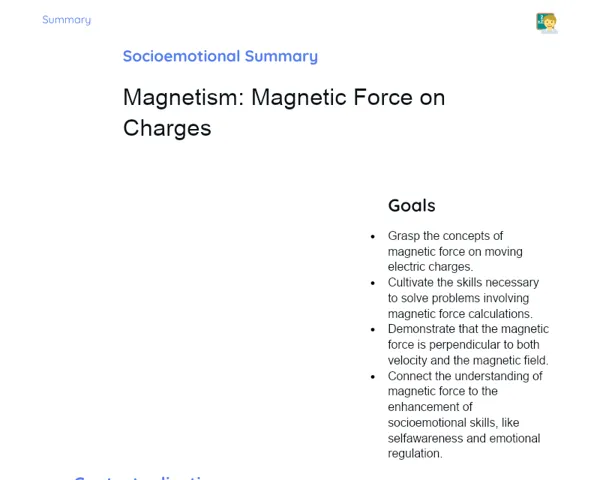Summary Tradisional | Magnetic Field: Loop
Contextualization
Magnetism is one of the fundamental forces of nature, and it is integral to many phenomena and technologies that we encounter in our daily lives. Common examples include simple magnets for refrigerator doors and complex devices like electric motors and generators. In the medical field, magnetic resonance imaging (MRI) leverages magnetic fields to produce detailed images of the human body's interior, underscoring the practical and widespread significance of magnetism.
A coil, which is essentially a wire bent into a circular shape, generates a magnetic field when an electric current flows through it. This concept is fundamental across various disciplines of physics and engineering as it enables us to comprehend and manipulate magnetic fields in different technological contexts. Gaining insight into the magnetic field created by a coil is vital not just for theoretical explorations but also for practical applications, ranging from powering electric motors to storing data on the magnetic strips found in credit cards.
To Remember!
Definition and Characteristics of a Coil
A coil is formed when a conductor is bent into a circular shape. When an electric current flows through the wire, a magnetic field is generated around it. This phenomenon illustrates how electric current can induce a magnetic field, which is a core principle in electromagnetism.
The strength of the magnetic field produced depends primarily on two factors: the radius of the coil and the intensity of the current. A larger radius results in a weaker magnetic field at the center for a constant current, while a higher current increases the strength of the magnetic field generated.
Coils serve as essential components across a wide range of technological applications. In devices like electric motors and generators, the magnetic fields generated by coils are instrumental in converting electrical energy to mechanical energy and vice versa. Furthermore, studying coils is crucial for developing technologies that use magnetic data storage.
-
A coil is a conductor bent into a circular shape.
-
The magnetic field generated by a coil is affected by its radius and current.
-
Coils are vital components in electric motors and generators.
Biot-Savart Law
The Biot-Savart Law provides a mathematical framework for calculating the magnetic field produced by a segment of current. This law is fundamental for understanding how the magnetic field varies in space around coils or any conductor. While the Biot-Savart Law has a somewhat complex mathematical expression, it is crucial for detailed analyses of magnetic fields.
According to this law, the magnetic field dB at a point due to a small segment of current I is directly proportional to the current and the length of this segment, while being inversely proportional to the square of the distance between the segment and the observation point. The law also incorporates the permeability of the medium, typically indicated by the permeability of free space (μ₀).
The Biot-Savart Law is indispensable for calculating magnetic fields in intricate geometries where the contributions from multiple current elements need to be considered. It is often applied in conjunction with the principle of superposition to tackle practical challenges in electromagnetism.
-
The Biot-Savart Law determines the magnetic field generated by a current element.
-
The magnetic field is directly related to the current and segment length.
-
The law is crucial for analyzing magnetic fields in complex systems.
Magnetic Field at the Center of the Coil
To calculate the magnetic field at the center of a coil, we apply the Biot-Savart Law. The specific formula for this scenario is B = (μ₀ * I) / (2 * R), where B represents the magnetic field, μ₀ is the permeability of free space, I is the current, and R is the radius of the coil. This formula simplifies the calculation of the magnetic field at this specific and significant location within the coil.
At the center of the coil, every segment of the current contributes symmetrically to the magnetic field, leading to a uniform magnetic field. The strength of this field is directly proportional to the current and inversely proportional to the coil's radius. The straightforward nature of this formula aids in addressing both practical and theoretical problems related to magnetic fields generated by coils.
Understanding the magnetic field at the center of the coil is critical for many technological applications. For instance, in magnetic resonance imaging systems, having a uniform magnetic field is vital for producing accurate images. Additionally, in laboratory setups, this formula enables precise prediction and control of magnetic fields.
-
The formula B = (μ₀ * I) / (2 * R) is used to calculate the magnetic field at the center of a coil.
-
The magnetic field increases with the current and decreases with the radius.
-
This formula is key for numerous technological and experimental applications.
Superposition of Magnetic Fields
The principle of superposition is vital for calculating the resultant magnetic field produced by multiple coils or other current elements. According to this principle, the total magnetic field at any given point is the vector sum of the individual magnetic fields generated by each segment of current. This means that one must carefully consider both the magnitude and direction of these fields.
Superposition becomes particularly handy in systems comprising several coils or windings, as seen in transformers and electric motors. By assessing each coil's contribution individually and summing them, one can accurately determine the resultant magnetic field. This principle also applies to more complicated scenarios involving the interaction of magnetic fields generated by various types of conductors.
Comprehending and applying the principle of superposition is crucial for resolving practical issues in electromagnetism. It simplifies the analysis of complex systems, aiding in the design and enhancement of electromagnetic devices. Moreover, superposition is a fundamental concept that extends beyond electromagnetism to other areas, such as wave theory and quantum mechanics.
-
The principle of superposition adds the individual magnetic fields vectorially.
-
It is beneficial in systems with multiple coils, like transformers and motors.
-
It facilitates the analysis and optimization of complex electromagnetic devices.
Key Terms
-
Magnetic Field: The area surrounding a magnet or electric current where magnetic forces can be observed.
-
Coil: A conductor shaped into a circle that generates a magnetic field when current flows through it.
-
Biot-Savart Law: A formula used to calculate the magnetic field from a current element.
-
Electric Current: The flow of electric charge through a conductor.
-
Permeability of Free Space (μ₀): A physical constant representing how well free space can allow the creation of a magnetic field.
-
Superposition of Magnetic Fields: A principle allowing the calculation of the resulting magnetic field as the vector sum of individual magnetic fields.
-
Electric Motors: Devices that convert electrical energy into mechanical energy via magnetic fields.
-
Generators: Devices that transform mechanical energy into electrical energy using magnetic fields.
-
Magnetic Resonance Imaging: A medical imaging technique that uses magnetic fields and radio waves for detailed images of the body.
Important Conclusions
In this lesson, we covered the significance of magnetism and its ubiquitous presence in various technologies in our day-to-day lives, such as electric motors and MRI. We learned that a coil is a conductor bent into a circular shape that generates a magnetic field when current flows through, and we discussed the Biot-Savart Law, which is key in calculating the magnetic fields arising from current elements.
We examined how to compute the magnetic field at the center of a coil using the formula B = (μ₀ * I) / (2 * R), emphasizing the direct relationship between current and magnetic field, as well as the inverse relationship with the coil's radius. Additionally, we touched upon the principle of superposition of magnetic fields, essential for resolving issues involving several coils or conductors.
The insights gained about magnetic fields from coils are vital for diverse technological and scientific applications. We encourage students to delve further into the subject, as grasping these concepts is crucial for advancements in new technologies and progress in electrical and electronic engineering.
Study Tips
-
Review basic electromagnetism concepts, such as magnetic fields and electric currents, to strengthen your theoretical grounding.
-
Practice solving problems related to the Biot-Savart Law and calculating magnetic fields at the center of coils to enhance your learning.
-
Investigate practical uses for the magnetic fields produced by coils, such as in electric motors and generators, to better appreciate the relevance of studied concepts.



